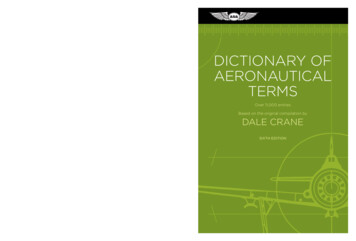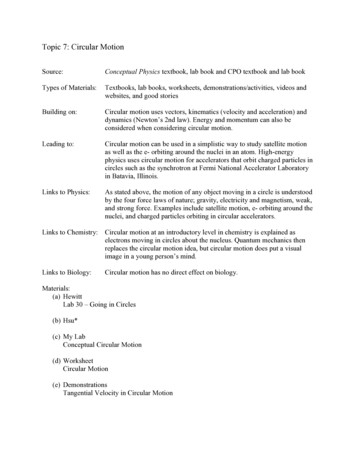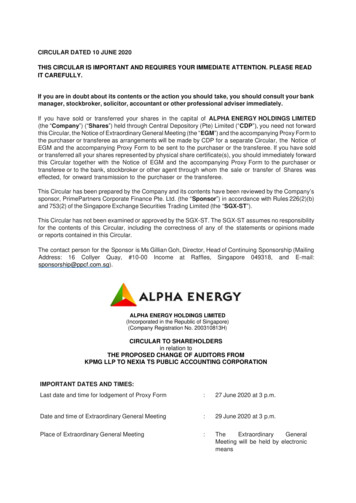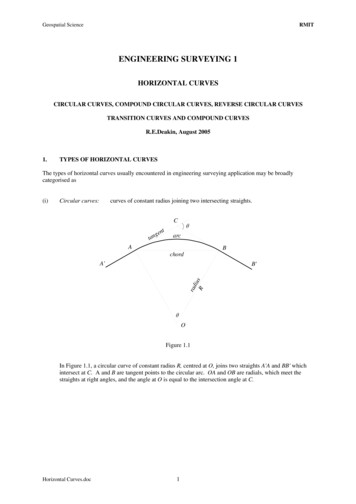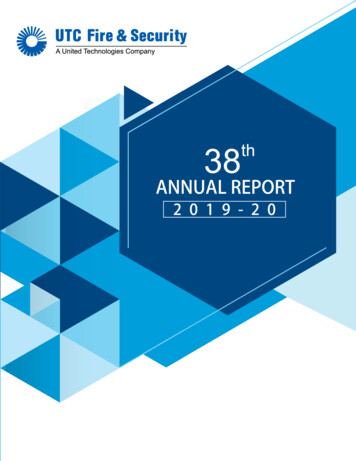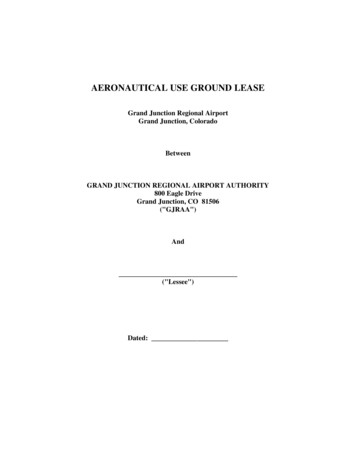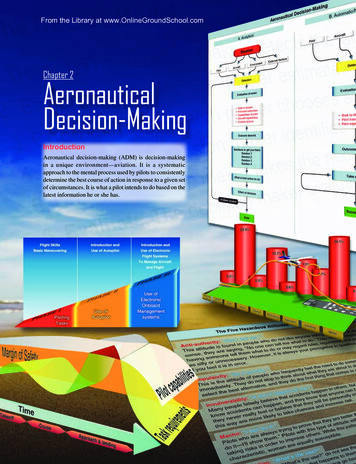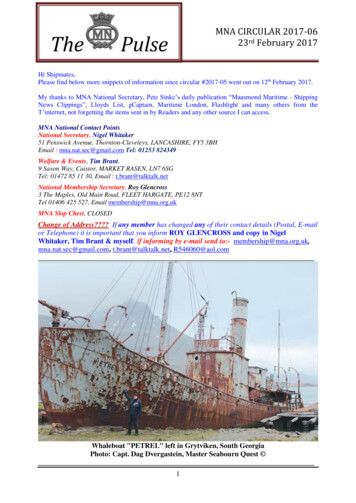
Transcription
0901Z 8 SEPTEMBER 20220901Z 6 OCTOBER 2022EFFECTIVETOAIP CANADAAeronauticalInformationCirculars
Published by NAV CANADA in accordance with ICAOAnnexes 4 and 15 of the Convention on International Civil Aviation 2022 NAV CANADA All rights reservedSource of Charts and Maps: 2022 Her Majesty the Queen in Right of CanadaDepartment of Natural Resources
NAV CANADA08 SEP 22AERONAUTICAL INFORMATION CIRCULARSUMMARY 5/22(Supersedes all previous summaries)The following Aeronautical Information Circulars are in effect:28/18Toronto/Lester B. Pearson International (CYYZ) New Night-Time Approach Procedures5/21Requesting Priority Handling for Flights Carrying COVID-19 Vaccines (ReplacesAIC 3/21)9/21Notice of Mandate to Apply Airport Collaborative Decision Making (A-CDM) Procedures atToronto/Lester B. Pearson International Airport (Replaces AIC 26/20)10/21Notice of Trial for Proposed Amended Preferential Runway System at Toronto/Lester B.Pearson International Airport (Replaces AIC 8/20)11/21Effects of Approach Light System Intensity on Instrument Flight Procedure Minima15/21Notice of Operational Trial: New Runway Hold Position Markings, Placement and LightingToronto/Lester B. Pearson International Airport18/21Trial to Remove Flight Planning Requirement of Eastbound North American Routes (NAR)(Replaces AIC 34/20)22/21Canada/USA Border Computer Navigation Fixes23/21Decommission of VHF Direction Finding24/21User Information for the Implementation of the Canadian Runway Surface ConditionNOTAM Format 12 August 2021 (Replaces AIC 33/20 and AIC 37/20)25/21Changes to Canadian SIGMET, AIRMET and TAF Bulletins32/21Pre-Taxi Clearance Implementation at Flight Service Staffed Airports in Canada3/22Thunder Bay, ON (CKE6) Water Aerodrome—Communication Procedure Change7/22Persons Operating Instrument Flight Rules Aircraft When Approaching or Landing at anUncontrolled Aerodrome8/22Oblique Angle Intersection Use at Controlled Airports9/22Time-Based Separation Implementation at Toronto/Lester B. Pearson InternationalAirport (CYYZ)10/22Change in Hours of Community Aerodrome Radio Station at Grise Fiord, Nunavut11/22NAVAID Modernization Program: Phase 812/22Notice of Further Expansion of Automatic Dependent Surveillance – Broadcast (ADS-B)Services Below Flight Level 290 (Supersedes AIC 6/22)14/22Common Frequency Areas Within a 50 Nautical Mile Radius of Montreal15/22Decommissioning of NAV CANADA Very High Frequency and Automated DependentSurveillance – Broadcast Stations Located in Southern Greenland (Replaces AIC 13/22)16/22Notifications on Overflying Conflict Zones Issued by Transport Canada (ReplacesAIC 37/21)19/22VFR Checkpoints21/22Aerodrome Forecast Hours—Dease Lake, British Columbia (CYDL)22/22Use of Controller Pilot Data Link Communications Route Clearance Messages in theMoncton Flight Information RegionNote: Cette information est aussi disponible dans l’autre langue officielle.Page 1 of 2
08 SEP 2223/22Controller-Pilot Data Link Communications Uplink Message Latency Monitor Function inGander Oceanic Control Area24/22Notice of Updated Timeline for ADS-B Out Performance Requirements Mandate inCanadian Domestic Airspace (Replaces AIC 2/22)25/22Implementation of SELCAL32 in Gander Oceanic Control Area26/22New Procedures for the Use of a Ground Advisory Frequency at Nanaimo (CYCD) Airport(Replaces AIC 18/22)27/22Procedures for the Use of a Ground Advisory Frequency at Mirabel (CYMX) Airport(Supersedes AIC 17/20)28/22Fort McMurray/Mildred Lake Airspace ChangesThe following Aeronautical Information Circulars have been cancelled:17/22Procedures for the Use of a Ground Advisory Frequency at Mirabel (CYMX) Airport(Supersedes AIC 30/20)18/22New Procedures for the Use of a Ground Advisory Frequency at Nanaimo (CYCD)Airport20/22Modification of Terrace Control ZonePage 2 of 2AERONAUTICAL INFORMATION CIRCULAR SUMMARY 5/22
NAV CANADA08 SEP 22AERONAUTICAL INFORMATION CIRCULAR 28/22FORT McMURRAY/MILDRED LAKE AIRSPACE CHANGESThe private Fort McMurray/Mildred Lake Aerodrome (CER4) has been permanently closed and theassociated instrument approach procedures (IAPs) have been revoked. This closure has resulted in there nolonger being a requirement for the Class E control zone (CZ) and transition area (TA) at Mildred Lake.The Mildred Lake CZ and TA will be removed.The North Oil Sands Aerodrome Traffic Frequency (ATF) area will remain unchanged.NOT FOR NAVIGATIONNote: Cette information est aussi disponible dans l’autre langue officielle.Page 1 of 2
08 SEP 22This change will take effect 03 November 2022 at 0901 Coordinated Universal Time (UTC). Theappropriate aeronautical publications will be amended. Refer to this aeronautical information circular (AIC),the relevant AIP Supplement or the Designated Airspace Handbook (TP 1820E) until the Lake Athabascavisual flight rules (VFR) navigation chart (VNC) is updated, which is planned for September 2024.For further information, please contact:NAV CANADACustomer ServiceOttawa, navcanada.ca Chris BowdenActing Director, Aeronautical Information Management and Flight OperationsPage 2 of 2AERONAUTICAL INFORMATION CIRCULAR 28/21
NAV CANADA08 SEP 22AERONAUTICAL INFORMATION CIRCULAR 27/22PROCEDURES FOR THE USE OF A GROUND ADVISORYFREQUENCY AT MIRABEL (CYMX) AIRPORT(Supersedes AIC 17/22)The purpose of this aeronautical information circular (AIC) is to inform pilots and air traffic services (ATS) ofprocedures associated with the ground advisory (GND ADV) frequency for use at Montréal International /Mirabel Airport (CYMX).Procedures When the GND ADV frequency is operational, pilots operating on the apron and taxiwaysup to the hold line for runways in use at Mirabel Airport will be exempt from maintaininga continuous listening watch and making reports on the mandatory frequency (MF)(reference: Canadian Aviation Regulations [CARs] subsections 602.97 [2], 602.98 [1], andsection 602.99). While operating on the ground, ATS will instruct pilots to make all frequencychanges. New operating restrictions regarding communications on the MF and the GND ADVfrequency will be specified by the Minister in the Canada Flight Supplement (CFS). Procedures for use of the GND ADV frequency at Mirabel Airport have been published in theappropriate aeronautical publications, as noted below.Pursuant to CARs subsection 602.98 (1), for aircraft operating on the apron and taxiways at Mirabel Airportup to the hold line before the runway in use, the Minister has authorized NAV CANADA ATS to specifyoperating restrictions regarding communications intended for the MF and assign a GND ADV frequency. Thisaction has been taken to reduce the frequency congestion on the MF and reduce safety hazards associatedwith such congestion.Coincident with this action, during periods when the GND ADV frequency is operational, pilots will be exemptfrom the requirements of CARs sections 602.97, 602.98, and 602.99. Pilots must still adhere to CARssections 602.100 to 602.103, inclusive.Referenced CARs are reproduced in Appendix A on page 3 of this AIC.Pilots are advised to review the exemption and adhere to the conditions listed in the most current version of“Exemption from Subsections 602.97 (2), 602.98 (1), and Section 602.99 of the Canadian AviationRegulations.” This can be found on the Transport Canada website under “Exemptions to the CanadianAviation Regulations (CARs)”: exemptions-canadianaviation-regulations-cars NAV CANADA will provide ground traffic information, pre-taxi clearances (where available), and otheradvisory information on the GND ADV frequency.During this time, the automatic terminal information service (ATIS) message will contain information to pilotsregarding use of the GND ADV frequency.Note: Cette information est aussi disponible dans l’autre langue officielle.Page 1 of 4
08 SEP 22The following aeronautical publications reflect this additional frequency: Canada Flight Supplement (CFS) Canada Air Pilot, “Instrument Procedures — General Pages” (CAP GEN) Canada Air Pilot Volume 5, “Instrument Procedures — Quebec” (CAP Volume 5) Canada Air Pilot Volume 6, “Procédures aux instruments — Québec” (CAP Volume 6)Refer to the CFS “General Section”, CAP Volume 6 and the CAP GEN for a definition of Ground Advisory.Refer to the CFS, Section B “Aerodrome/Facility Directory”, CAP Volume 5, and CAP Volume 6 for moredetailed information specific to Mirabel Airport, such as frequency and procedures.Phraseology examples that pilots can expect from flight service specialists (FSS) include: Instruction to change to the appropriate frequency (after receipt of advisory information):Pilot:GOLF ALFA BRAVO CHARLIE ON BRAVO FOR RUNWAY TWOTHREE AT ALFAGND ADV:ROGER, CONTACT RADIO ON (frequency)Recommended taxi routing during complex ground traffic situations:SUGGEST TAXI VIA BRAVO, ECHO, JULIET, ALFA. HOLD SHORT RUNWAY ONE ONEorRECOMMEND TAXI VIA TANGO, BRAVO, RUNWAY TWO FOUR When transferring aircraft to either frequency (if the FSS positions are combined):CHANGE TO MY FREQUENCY (frequency)This AIC supersedes AIC 17/22 and will not expire unless superseded by a change in the level of service, orby amendment of, exemption from, or interpretation of the Canadian Aviation Regulations.If you have any questions or concerns, please contact:NAV CANADACustomer Service77 Metcalfe StreetOttawa, ON K1P @navcanada.caVanessa RobertsonDirector Air Traffic Services (ATS) StandardsPage 2 of 4AERONAUTICAL INFORMATION CIRCULAR 27/21
08 SEP 22APPENDIX ADivision V — Operations at or in the Vicinity of an AerodromeVFR and IFR Aircraft Operations at Uncontrolled Aerodromes within an MF Area602.97 (1) Subject to subsection (3), no pilot-in-command shall operate a VFR or IFR aircraft within an MFarea unless the aircraft is equipped with radiocommunication equipment pursuant to Subpart 5.(2) The pilot-in-command of a VFR or IFR aircraft operating within an MF area shall maintain a listening watchon the mandatory frequency specified for use in the MF area.(3) The pilot-in-command of a VFR aircraft that is not equipped with the radiocommunication equipmentreferred to in subsection (1) may operate the aircraft to or from an uncontrolled aerodrome that lies withinan MF area if(a) a ground station is in operation at the aerodrome;(b) prior notice of the pilot-in-command’s intention to operate the aircraft at the aerodrome has beengiven to the ground station;(c) when conducting a take-off, the pilot-in-command ascertains by visual observation that there is nolikelihood of collision with another aircraft or a vehicle during take-off; and(d) when approaching for a landing, the aircraft enters the aerodrome traffic circuit from a positionthat will require it to complete two sides of a rectangular circuit before turning onto the finalapproach path.General MF Reporting Requirements602.98 (1) Every report made pursuant to this Division shall be made on the mandatory frequency that hasbeen specified for use in the applicable MF area.(2) Every report referred to in subsection (1) shall be(a) directed to the ground station associated with the MF area, if a ground station exists and is inoperation; or(b) broadcast, if a ground station does not exist or is not in operation.MF Reporting Procedures before Entering Manoeuvring Area602.99 The pilot-in-command of a VFR or IFR aircraft that is operated at an uncontrolled aerodrome that lieswithin an MF area shall report the pilot-in-command’s intentions before entering the manoeuvring area of theaerodrome.MF Reporting Procedures on Departure602.100 The pilot-in-command of a VFR or IFR aircraft that is departing from an uncontrolled aerodrome thatlies within an MF area shall(a) before moving onto the take-off surface, report the pilot-in-command’s departure procedureintentions;(b) before take-off, ascertain by radiocommunication and by visual observation that there is nolikelihood of collision with another aircraft or a vehicle during take-off; and(c) after take-off, report departing from the aerodrome traffic circuit.AERONAUTICAL INFORMATION CIRCULAR 27/21Page 3 of 4
08 SEP 22MF Reporting Procedures on Arrival602.101 The pilot-in-command of a VFR aircraft arriving at an uncontrolled aerodrome that lies within anMF area shall report(a) before entering the MF area and, where circumstances permit, shall do so at least five minutesbefore entering the area, giving the aircraft’s position, altitude and estimated time of landing andthe pilot-in-command’s arrival procedure intentions;(b) when joining the aerodrome traffic circuit, giving the aircraft’s position in the circuit;(c) when on the downwind leg, if applicable;(d) when on final approach; and(e) when clear of the surface on which the aircraft has landed.MF Reporting Procedures When Flying Continuous Circuits602.102 The pilot-in-command of a VFR aircraft carrying out continuous circuits at an uncontrolled aerodromethat lies within an MF area shall report(a) when joining the downwind leg of the circuit;(b) when on final approach, stating the pilot-in-command’s intentions; and(c) when clear of the surface on which the aircraft has landed.Reporting Procedures When Flying through an MF Area602.103 The pilot-in-command of an aircraft flying through an MF area shall report(a) before entering the MF area and, where circumstances permit, shall do so at least five minutesbefore entering the area, giving the aircraft’s position and altitude and the pilot-in-command’sintentions; and(b) when clear of the MF area.Page 4 of 4AERONAUTICAL INFORMATION CIRCULAR 27/21
NAV CANADA08 SEP 22AERONAUTICAL INFORMATION CIRCULAR 26/22NEW PROCEDURES FOR THE USE OF A GROUNDADVISORY FREQUENCY AT NANAIMO (CYCD) AIRPORT(Replaces AIC 18/22)The purpose of this aeronautical information circular (AIC) is to inform pilots and air traffic services (ATS) ofnew procedures associated with the introduction of a ground advisory (GND ADV) frequency for use atNanaimo Airport (CYCD).Procedures When the GND ADV frequency is operational, pilots operating on the apron and taxiwaysup to the hold line for runways in use at Nanaimo Airport will be exempt from maintaininga continuous listening watch and making reports on the mandatory frequency (MF)(reference: Canadian Aviation Regulations [CARs] subsections 602.97 (2), 602.98 (1), andsection 602.99). While operating on the ground, ATS will instruct pilots to make all frequencychanges. New operating restrictions regarding communications on the MF and the GND ADVfrequency will be specified by the Minister in the Canada Flight Supplement (CFS). New procedures for use of the GND ADV frequency at Nanaimo Airport will be published inappropriate aeronautical publications, as noted below.Pursuant to CARs subsection 602.98 (1), the Minister has authorized NAV CANADA ATS to specify operatingrestrictions regarding communications intended for the MF and assign a GND ADV frequency for use atNanaimo Airport, for aircraft operating on the apron and taxiways up to the hold line before the runway in use.This action has been taken to reduce the frequency congestion on the MF and reduce safety hazardsassociated with said congestion.Coincident with this action, during periods when the GND ADV frequency is operational, pilots will be exemptfrom the requirements of CARs sections 602.97, 602.98, and 602.99. Pilots must still adhere to CARssections 602.100 to 602.103, inclusive.Referenced CARs are reproduced in Appendix A on page 3 of this AIC.Pilots are advised to review the exemption and adhere to the conditions listed in the most current version of“Exemption from Subsections 602.97 (2), 602.98 (1), and Section 602.99 of the Canadian AviationRegulations.” This can be found on the Transport Canada website under “Exemptions to the CanadianAviation Regulations (CARs)”: exemptions-canadianaviation-regulations-cars .Effective 16 June 2022, NAV CANADA will provide ground traffic information, pre-taxi clearances (whereavailable), and other advisory information on the GND ADV frequency.During this change, the automatic terminal information service (ATIS) message will contain information topilots regarding use of the GND ADV frequency.Note: Cette information est aussi disponible dans l’autre langue officielle.Page 1 of 4
08 SEP 22The following aeronautical publications will be amended to reflect this additional frequency: Canada Flight Supplement (CFS) Canada Air Pilot, “Instrument Procedures — General Pages” (CAP GEN) Canada Air Pilot, Volume 2, “Instrument Procedures — British Columbia” (CAP Volume 2)Refer to the CFS “General Section” and the CAP GEN for a definition of Ground Advisory. Refer to the CFS,Section B “Aerodrome/Facility Directory” and CAP Volume 2 for more detailed information specific toNanaimo Airport, such as frequency and procedures.Phraseology examples that pilots can expect from flight service specialists include: Instruction to change to the appropriate frequency (after receipt of advisory information):Pilot:GOLF ALFA BRAVO CHARLIE ON BRAVO FOR RUNWAY TWOTHREE AT ALFAGND ADV:ROGER, CONTACT RADIO ON (frequency)Recommended taxi routing during complex ground traffic situations:SUGGEST TAXI VIA BRAVO, ECHO, JULIET, ALFA HOLD SHORT RUNWAY ONE ONEorRECOMMEND TAXI VIA TANGO, BRAVO, RUNWAY TWO FOUR When transferring aircraft to either frequency (if the FSS positions are combined):CHANGE TO MY FREQUENCY (frequency)This AIC will not expire unless superseded by a change in the level of service, or by amendment of,exemption from, or interpretation of the Canadian Aviation Regulations.If you have any questions or concerns, please contact:NAV CANADACustomer Service77 Metcalfe StreetOttawa, ON K1P @navcanada.caVanessa RobertsonDirector Air Traffic Services (ATS) StandardsPage 2 of 4AERONAUTICAL INFORMATION CIRCULAR 26/21
08 SEP 22APPENDIX ADivision V — Operations at or in the Vicinity of an AerodromeVFR and IFR Aircraft Operations at Uncontrolled Aerodromes within an MF Area602.97 (1) Subject to subsection (3), no pilot-in-command shall operate a VFR or IFR aircraft within an MFarea unless the aircraft is equipped with radiocommunication equipment pursuant to Subpart 5.(2) The pilot-in-command of a VFR or IFR aircraft operating within an MF area shall maintain a listening watchon the mandatory frequency specified for use in the MF area.(3) The pilot-in-command of a VFR aircraft that is not equipped with the radiocommunication equipmentreferred to in subsection (1) may operate the aircraft to or from an uncontrolled aerodrome that lies withinan MF area if(a) a ground station is in operation at the aerodrome;(b) prior notice of the pilot-in-command’s intention to operate the aircraft at the aerodrome has beengiven to the ground station;(c) when conducting a take-off, the pilot-in-command ascertains by visual observation that there is nolikelihood of collision with another aircraft or a vehicle during take-off; and(d) when approaching for a landing, the aircraft enters the aerodrome traffic circuit from a positionthat will require it to complete two sides of a rectangular circuit before turning onto the finalapproach path.General MF Reporting Requirements602.98 (1) Every report made pursuant to this Division shall be made on the mandatory frequency that hasbeen specified for use in the applicable MF area.(2) Every report referred to in subsection (1) shall be(a) directed to the ground station associated with the MF area, if a ground station exists and is inoperation; or(b) broadcast, if a ground station does not exist or is not in operation.MF Reporting Procedures before Entering Manoeuvring Area602.99 The pilot-in-command of a VFR or IFR aircraft that is operated at an uncontrolled aerodrome that lieswithin an MF area shall report the pilot-in-command’s intentions before entering the manoeuvring area of theaerodrome.MF Reporting Procedures on Departure602.100 The pilot-in-command of a VFR or IFR aircraft that is departing from an uncontrolled aerodrome thatlies within an MF area shall(a) before moving onto the take-off surface, report the pilot-in-command’s departure procedureintentions;(b) before take-off, ascertain by radiocommunication and by visual observation that there is nolikelihood of collision with another aircraft or a vehicle during take-off; and(c) after take-off, report departing from the aerodrome traffic circuit.AERONAUTICAL INFORMATION CIRCULAR 26/21Page 3 of 4
08 SEP 22MF Reporting Procedures on Arrival602.101 The pilot-in-command of a VFR aircraft arriving at an uncontrolled aerodrome that lies within anMF area shall report(a) before entering the MF area and, where circumstances permit, shall do so at least five minutesbefore entering the area, giving the aircraft’s position, altitude and estimated time of landing andthe pilot-in-command’s arrival procedure intentions;(b) when joining the aerodrome traffic circuit, giving the aircraft’s position in the circuit;(c) when on the downwind leg, if applicable;(d) when on final approach; and(e) when clear of the surface on which the aircraft has landed.MF Reporting Procedures When Flying Continuous Circuits602.102 The pilot-in-command of a VFR aircraft carrying out continuous circuits at an uncontrolled aerodromethat lies within an MF area shall report(a) when joining the downwind leg of the circuit;(b) when on final approach, stating the pilot-in-command’s intentions; and(c) when clear of the surface on which the aircraft has landed.Reporting Procedures When Flying through an MF Area602.103 The pilot-in-command of an aircraft flying through an MF area shall report(a) before entering the MF area and, where circumstances permit, shall do so at least five minutesbefore entering the area, giving the aircraft’s position and altitude and the pilot-in-command’sintentions; and(b) when clear of the MF area.Page 4 of 4AERONAUTICAL INFORMATION CIRCULAR 26/21
NAV CANADA08 SEP 22AERONAUTICAL INFORMATION CIRCULAR 25/22IMPLEMENTATION OF SELCAL32 IN GANDEROCEANIC CONTROL AREAIntroductionGander international flight service station (IFSS) has the selective calling system (SELCAL) installed on allinternational frequencies at Gander Radio. It is used to instruct flight crews to call air traffic services (ATS) ona specific high frequency (HF) radio frequency. Because of this, the use of SELCAL codes enables flightcrews to maintain a SELCAL watch in place of a listening watch on HF.BackgroundThe number of codes available are limited and can lead to similar code assignments to aircraft that are inclose proximity to one another. Due to the safety implications of this, the International Civil AviationOrganization (ICAO) has enabled the use of an additional 16 alphanumeric designations, increasing the listto 32. Equipment for both air navigation service providers (ANSPs) and aircraft will need to be upgraded toallow for the transmission and receipt of the alphanumeric codes. The applicability date for this has been setby ICAO to be 03 November 2022.Equipped aircraft operators can contact Aviation Spectrum Resources, Inc. (ASRI) for verification of aSELCAL code that can include any of the 32 alphanumeric designations available.However, due to resource allocation in the recovery from the pandemic, NAV CANADA and other NorthAtlantic (NAT) ANSPs will not be ready to transmit the additional codes until the spring 2023.ProceduresFor flight crews who are not equipped to receive the additional codes, there are no changes.Flight crews who have received verification of a new 4-digit combination of the 32 alphanumeric codes willneed to do one of the following to continue receiving HF service from Gander Radio: Retain your original SELCAL code if possible and continue to use it until the spring 2023; or Maintain a listening watch on the applicable HF radio frequency.DocumentationRefer to AIP Canada, Part 1 – General (GEN), Section GEN 3.4 and Part 2 – Enroute (ENR), SectionENR 7.5 for more information on the SELCAL services and procedures in the Gander oceanic controlarea (OCA).For more information on ICAO standards and recommended practices (SARPs) related to SELCAL, refer tothe following publications: ICAO Annex 10 – Aeronautical Telecommunications, Volume II, Chapter 5 ICAO Annex 10 – Aeronautical Telecommunications, Volume III, Chapter 3 ICAO Doc 4444 – PANS-ATM , Chapters 10, 15 and Appendices 2 and 3 ICAO Doc 7030 – Regional Supplementary Procedures, NAT Region, Chapter 3 ICAO Doc 9432 – Manual of RadiotelephonyNote: Cette information est aussi disponible dans l’autre langue officielle.Page 1 of 2
08 SEP 22 ICAO Doc 9433 – Manual Concerning Interception of Civil Aircraft, Chapter 3 ICAO Doc 9694 – Manual of Air Traffic Data Link Applications Part VI ATS Interfacility datacommunications (AIDC), Chapter 4 ICAO Doc 10037 – Global Operational Data Link (GOLD) Manual, Chapters 2, 3, 4, andAppendix BFor further information, please contact:NAV CANADAGander Area Control CentreP.O. Box 328Gander, NL A1V 1W7Attn: Robert Fleming, ManagerACC OperationsDirect line: ssa RobertsonDirector Air Traffic Services (ATS) StandardsPage 2 of 2AERONAUTICAL INFORMATION CIRCULAR 25/21
NAV CANADA11 AUG 22AERONAUTICAL INFORMATION CIRCULAR 24/22NOTICE OF UPDATED TIMELINE FORADS-B OUT PERFORMANCE REQUIREMENTSMANDATE IN CANADIAN DOMESTIC AIRSPACE(Replaces AIC 2/22)IntroductionIn February of 2022, Canada announced an automatic dependent surveillance – broadcast out (ADS-B Out)Performance Requirements Mandate for applicable Canadian Domestic Airspace. The mandate put forward aphased approach to expand the delivery of safety and efficiency benefits made possible by the availability ofspace-based ADS-B surveillance, with the first phase planned for implementation beginning in early 2023.Since that announcement, NAV CANADA and Transport Canada have worked closely to evaluate stakeholderfeedback and, due to supply-chain limitations experienced by some customers in the context of the globalpandemic, a review of the effective dates was carried out and the implementation timeline is being updated.This aeronautical information circular outlines the updated ADS-B Out Performance Requirements Mandateimplementation phases, areas of applicability, and equipage requirements, and provides background onADS-B usage in Canada. It also outlines safety and efficiency benefits associated with the capability forexpansion of surveillance to areas where it was previously not available, thereby providing greater situationalawareness for air traffic service personnel and pilots.BackgroundADS-B Out is an electronic surveillance technology on board an aircraft that automatically broadcasts flightinformation from the aircraft via a digital data link. The data is used by air traffic systems to depict theaircraft’s position and altitude on display screens.NAV CANADA, the air navigation service provider for Canada, has provided ground-based ADS-Bsurveillance service in portions of CDA at flight level (FL) 290 and above since 2008. The availability ofspace-based ADS-B since 2019 has enabled air traffic service (ATS) surveillance throughout the entirety ofCDA. This has brought many benefits in areas and at altitudes where coverage was previously unavailable,by enabling significant safety, operational and infrastructure efficiency gains. In areas where ATS surveillancealready exists, the introduction of ADS-B for surveillance will provide value by removing coverage gaps andadding redundancy in surveillance sources, resulting in more seamless operations and a stronger system.The implementation of the ADS-B Out Performance Requirements Mandate leverages advancements insatellite-based navigation and aligns with International Civil Aviation Organization (ICAO) and TransportCanada performance-based navigation (PBN) plans.Equipage RequirementsTo demonstrate compliance with the ADS-B Out mandate, aircraft will be required to: be equipped with an appropriate transponder with ADS-B Out capabilities and performancewith the applicable standard of Radio Technical Commission for Aeronautics (RTCA)DO-260B, “Minimum Operational Performance Standards,” or newer. have antenna capability for broadcast toward space-based ADS-B receivers emitting1090 MHz extended squitter. This requirement can be met either through antenna diversity(the use of a top and bottom antenna) or with a single antenna that is capable of transmittingboth towards the ground and up towards satellites.Note: Cette information est aussi disponible dans l’autre langue officielle.Page 1 of 3
11 AUG 22Operators are expected to file the following ADS-B equipage in Item 10 of the ICAO flight plan: B1 ADS-B with dedicated 1090 MHz ADS-B “Out” capability, or B2 ADS-B with dedicated 1090 MHz ADS-B “Out” and “In” capability.Area of Applicability and Phased ImplementationThe ADS-B Out mandate will be enabled through airspace classification designation and amendment totransponder airspace requirements, as described in the Designated Airspace Handbook (DAH), TP 1820E.Implementation is planned to occur over multiple phases: Class A airspace commencing 10 August 2023 Class B airspace commencing 16 May 2024 Class C, D and E airspace commencing no earlier than 2026Class F and Class G airspace are not affected by the ADS-B Out mandate.This approach will help achieve the maximum benefits of a performance-based mandate within acceptabletimelines, while providing aircraft operators and owners adequate time to meet the equipage requirementsgiven aviation’s supply-chain considerations.Page 2 of 3AERONAUTICAL INFORMATION CIRCULAR 24/22
11 AUG 22BenefitsThe greatest benefits for ATS surveillance are achieved if all aircraft are appropriately equipped. Mandatingthe equipage of all aircraft w
Designated Airspace Handbook (TP 1820E) until the Lake Athabasca visual flight rules (VFR) navigation chart (VNC) is updated, which is planned for September 2024. For further information, please contact: NAV CANADA Customer Service Ottawa, ON . Tel.: 800-876-4693 Fax: 877-663-6656 E-mail: service@navcanada.ca Chris Bowden Acting Director, Aeronautical Information Management and Flight .
